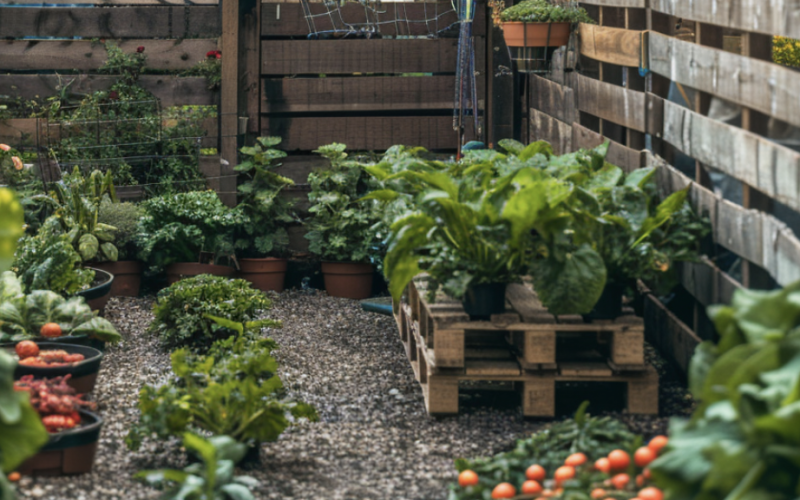When considering materials for your fence, wooden pallets might seem like an attractive, low-cost option.
However, while they may offer some pallet fence inspirations, using wooden pallets for fencing has several significant drawbacks.
This article will explore the downsides of choosing wooden pallets for your fencing project, including their lack of durability, potential safety hazards, and vulnerability to the elements.
By understanding these limitations, you can make a more informed decision about the best material for your fence, ensuring that it looks good and stands the test of time.
So, let’s explore why wooden pallets might not be ideal for your fencing needs.
Disadvantages of Using Wooden Pallets for Fencing
1. Durability and Maintenance
Wooden pallets, while readily available and inexpensive, have several shortcomings regarding durability and maintenance.
One of the primary issues with using wooden pallets for fencing is their susceptibility to deterioration over time.
Exposure to the elements, such as rain, sunlight, and temperature fluctuations, can cause the wood to splinter, crack, and eventually break.
This deterioration compromises the fence’s structural integrity and creates potential safety hazards for those who come into contact with it.
Moreover, wooden pallets require frequent maintenance and replacement compared to alternative materials like plastic.
The organic nature of wood makes it more prone to decay, insect infestations, and moisture damage, which can lead to a shorter lifespan for your fence.
As a result, you may find yourself constantly repairing or replacing sections of your wooden pallet fence, which can be time-consuming and costly in the long run.
2. Health and Safety Concerns
When considering wooden pallets for your fencing project, knowing their potential health and safety risks is crucial.
One significant concern is the difficulty in properly cleaning and sanitizing wooden pallets.
The porous nature of wood makes it challenging to remove dirt, debris, and other contaminants that can accumulate over time.
This limitation can lead to the growth of bacteria and fungus, especially in damp or humid conditions, and pose health risks to those who come into contact with the fence.
Another safety hazard associated with wooden pallet fences is the risk of contamination from wood splinters and nails.
As the pallets age and deteriorate, they become more prone to splintering, injuring people and pets who brush against or touch the fence.
Additionally, the nails or other fasteners used to assemble the pallets can become loose or exposed, creating a risk of puncture wounds or other injuries.
3. Environmental and Regulatory Implications

When deciding on fencing material, it’s important to consider the environmental impact and potential regulatory implications.
One of the main concerns with using wooden pallets for fencing is the issue of disposal and recycling.
While wood is a natural material, the limited lifecycle of recycled wood poses challenges regarding sustainable waste management.
Unlike plastic pallets, which can be recycled multiple times, wooden pallets have a shorter lifespan and may end up in landfills after just a few uses.
Moreover, certain regions and industries have specific regulations regarding using and treating wooden pallets.
For example, some countries require wooden pallets to be heat-treated or fumigated before being used for transportation or storage.
Failing to comply with these regulations can result in penalties or even the rejection of goods.
When repurposing wooden pallets for fencing, it’s crucial to ensure they meet applicable regulatory standards to avoid potential legal issues.
4. Economic Impact
While wooden pallets may initially seem like an affordable option for fencing, the long-term economic impact of this choice must be considered.
One of the most significant financial drawbacks of using wooden pallets is the direct costs associated with frequent replacements and maintenance.
The cost of regularly purchasing new pallets and the time and labor required to dismantle and reassemble the fence can quickly add up.
This ongoing expense can strain your budget and may ultimately outweigh any initial savings from using wooden pallets.
Furthermore, constant maintenance, such as treating the wood to prevent decay or repairing damaged sections, can contribute to the overall economic burden of maintaining a wooden pallet fence.
Conclusion
While wooden pallets may seem like an attractive option for fencing due to their availability and low initial cost, it’s crucial to consider their significant drawbacks.
Wooden pallets may not be ideal for your fencing needs due to their lack of durability and susceptibility to deterioration, as well as their potential health and safety risks.
Additionally, the environmental impact and regulatory implications of wooden pallets should not be overlooked.
When considering the long-term economic burden of frequent replacements and maintenance, it becomes clear that investing in alternative materials, such as plastic pallets or purpose-built fencing, maybe a more prudent decision.
By carefully weighing these factors, you can ensure that your fence meets your aesthetic preferences and stands the test of time.











